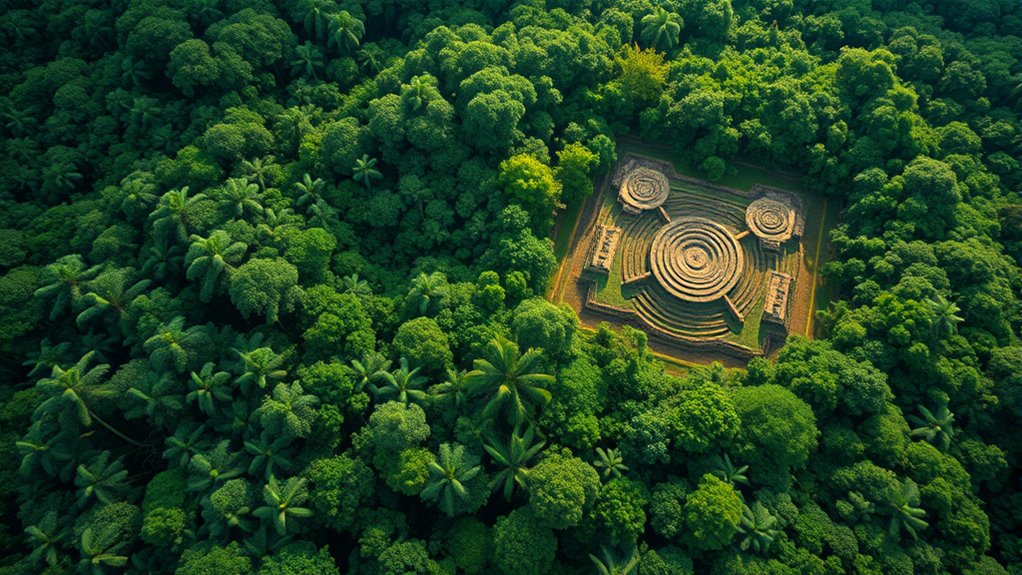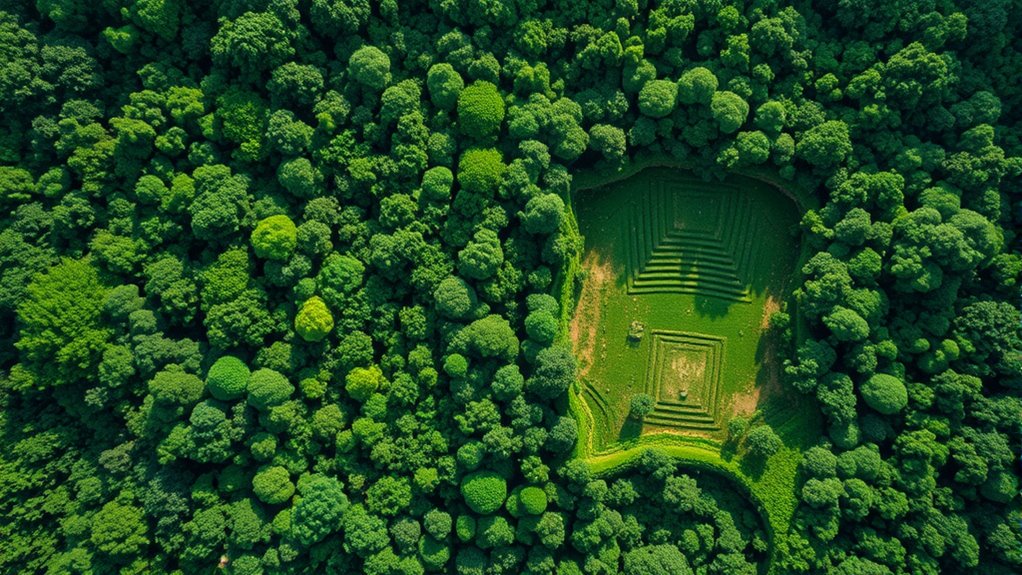Lidar technology has revealed an enormous, sophisticated civilization hidden beneath the Amazon rainforest. It shows complex urban planning, including interconnected settlements, ceremonial sites, and advanced agriculture like raised fields and irrigation. These findings indicate that ancient Amazon residents actively shaped and managed their environment, supporting large populations. This discovery rewrites the history of the rainforest as a place of thriving human activity. If you want to learn more about this groundbreaking find, keep exploring the details behind these surprising revelations.
Key Takeaways
- Lidar technology uncovered extensive ancient structures and landscapes concealed by dense Amazon rainforest foliage.
- Discovered sophisticated agricultural systems like raised fields, terraced gardens, and irrigation channels.
- Revealed interconnected settlements with organized streets, plazas, and ceremonial earthworks.
- Showed that ancient Amazon societies actively managed their environment for sustainability and resilience.
- Transformed understanding of the Amazon into a landscape of complex, thriving civilizations rather than wild jungle.

Thanks to advances in lidar technology, researchers are uncovering a thriving civilization hidden beneath the Amazon rainforest. This breakthrough allows you to see through dense foliage, revealing vast structures and landscapes that were previously invisible. As you explore these discoveries, it becomes clear that this ancient society was far more sophisticated than once thought, with complex systems of ancient farming and urban planning shaping their environment.
Lidar reveals a sophisticated ancient civilization shaping the Amazon’s landscape through advanced farming and urban planning.
You might imagine this civilization as a network of carefully managed agricultural zones. The lidar imagery shows evidence of raised fields, terraced gardens, and irrigation channels, all designed to maximize crop yields in the challenging rainforest terrain. These features suggest that the inhabitants practiced intensive, organized farming—transforming the landscape to support a large population. This ancient farming wasn’t just about subsistence; it was about creating a sustainable system that could thrive in the humid, nutrient-poor soils of the region. You see evidence of crop rotation, water management, and soil enrichment, indicating a deep understanding of ecology and resource management.
In addition to their agricultural expertise, the civilization displayed advanced urban planning. The lidar scans reveal a network of interconnected settlements, with organized streets, plazas, and ceremonial sites. You notice that these structures are strategically placed, often aligned with natural features or celestial events, pointing to a society with sophisticated knowledge of astronomy and spatial organization. The layout suggests they designed their urban spaces to facilitate social cohesion, governance, and religious practices. The presence of large earthworks, such as mounds and causeways, indicates they built monumental structures for ceremonial purposes, emphasizing the importance of community identity and spiritual life.
What’s most striking is how these urban features and farming systems coalesce into a well-organized civilization that managed its environment rather than simply adapting to it. The evidence points to a society that carefully planned its agriculture and built its infrastructure to sustain a large population over centuries. You can now visualize how these ancient inhabitants engineered their landscape, creating a resilient, thriving community that thrived amidst the challenges of the rainforest.
This discovery fundamentally shifts your understanding of the Amazon’s history. It’s no longer just a wild jungle with scattered tribes but a complex, interconnected civilization that mastered both ancient farming techniques and urban planning. Thanks to lidar technology, you’re witnessing the remnants of a society that once shaped the rainforest itself—an incredible chapter in human history hidden just beneath your feet.
Furthermore, this revelation underscores how attention and meticulous planning were likely vital to their success, demonstrating that focused effort and strategic organization can uncover and preserve complex ancient societies.
Frequently Asked Questions
What Specific Technologies Are Used in Lidar Scanning?
You use laser scanners in lidar technology, which emit rapid pulses of light to measure distances precisely. These sensors are often mounted on aircraft or drones for remote sensing. The collected data then undergoes data processing to create detailed 3D maps of the terrain and hidden structures. This combination allows you to explore and analyze landscapes, like the Amazon jungle, without disturbing the environment.
How Deep Can Lidar Penetrate Dense Jungle Canopies?
You might think dense jungle canopies block lidar, but it actually penetrates surprisingly deep—up to about 30 meters, or roughly 98 feet. Thanks to lidar accuracy and its laser pulses, you can reveal hidden structures beneath thick jungle layers. This technology cuts through the canopy, exposing what’s underneath, making it invaluable for uncovering lost civilizations and understanding jungle ecosystems more profoundly.
Were There Any Previous Discoveries of Civilizations in This Region?
You should know that previous discoveries in the Amazon region include remnants of ancient trade routes and pre-Columbian art. Archaeologists have uncovered pottery, stone structures, and artwork that suggest complex societies existed long before European contact. These findings indicate the area was once a thriving civilization with extensive networks. The recent lidar revelations build on this knowledge, revealing even more advanced urban centers and roads hidden beneath the jungle canopy.
How Does This Discovery Impact Our Understanding of Ancient Amazon Societies?
This discovery opens a window into ancient Amazon societies, showing that they were more sophisticated than we imagined. You realize that these civilizations mastered ancient agriculture, transforming the jungle into thriving urban centers with complex urban planning. It’s like uncovering a hidden puzzle piece, revealing that the Amazon was once a bustling landscape of innovation and community, challenging your previous ideas of untouched wilderness and highlighting their ingenuity and adaptability.
Are There Ongoing Efforts to Explore and Preserve the Site?
Yes, ongoing efforts focus on archaeological preservation and involve Indigenous communities, ensuring respectful exploration. You can support these initiatives by advocating for responsible research that safeguards the site’s integrity. Indigenous involvement helps protect cultural heritage and promotes sustainable practices. As researchers continue to explore, your awareness and support contribute to preserving this remarkable discovery for future generations, fostering collaboration that respects both the environment and local traditions.
Conclusion
As you stand in the shadowed jungle, this discovery whispers that even the densest canopies hide stories waiting to be uncovered. With lidar’s eye, the Amazon’s ancient heart beats anew, reminding you that beneath the wild, there’s a silent history yearning to be told. Just as the roots bind the forest, knowledge roots us deeper into understanding our shared past—hidden treasures waiting beneath the surface, urging you to look closer and listen.








